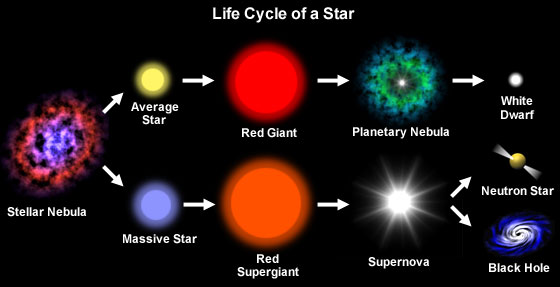What is a Star? : An Astronomical Object
A star is an astronomical object consisting of a luminous spheroid of gas, mostly hydrogen & helium, held together by opposing forces of energy. At its core, energy is created by nuclear fusion causing the gases to expand and exert an outward pressure.. This outward pressure is balanced by the inward pull of gravity, leaving the star in hydrostatic equilibrium. This balance of forces lasts for most of a star’s life.
A STAR IS BORN: The Life Cycle of a Star

★ 75% of the matter in the universe is hydrogen and 23% is helium. These elements exist in large stable dust clouds of cold molecular gas called Nebulae. A star’s life cycle is determined by its mass. The larger its mass, the shorter its life cycle. A star’s mass is determined by the amount of matter that is available in its nebula. The birth of a star takes place in a nebula.
★ The birth of a star begins with the collapse of a nebula. An intergalactic collision or a nearby supernova explosion causes pockets of matter inside of the nebula to collapse under their own weight. As it collapses, gravitational forces cause the nebular fragments to be pulled together and spin. As the stellar material pulls tighter and tighter together, its temperature rises, creating outward energy that counters further gravitational collapse. At this point in its lifecycle, the rotating sphere of gaseous material is known as a Protostar. This phase lasts about 100 000 years.
Surrounding the protostar is a circumstellar disk of gas and dust from the collapsing nebula. . Some of this continues to spiral inward, layering additional mass onto the star. The rest will remain in place and eventually form a planetary system
★As a protostar evolves and continues to pull inward, it spins even more rapidly because of the principle of “conservation of angular momentum”. Rising core pressure creates rising core and surface temperatures, which gives surface gases sufficient energy to escape the gravitational attraction of the star as stellar wind. At this point in its lifecycle, the star is considered a T-Tauri Star.
Further development of a star is determined by its mass. Mass is typically compared to the mass of the Sun: 1.0 M☉ (2.0×1030 kg) means 1 solar mass.
★ The core temperature of a protostar with a mass greater than 0.08 M☉ (1.6×1029 kg) eventually, (over about 100 million years) reaches 15 million ºC, allowing nuclear fusion to occur at its core. At this point in its lifecycle, the star is considered a Main Sequence Star. Nuclear fusion converts hydrogen to helium. This reaction is exothermic; it gives off more heat than it requires, and so the core of a main sequence star releases a tremendous amount of energy as light. All of this light pushes outward on the star, and counteracts the gravitational force pulling it inward. A star at this stage of life is held in balance as long as its supply of hydrogen fuel lasts.
And how long does this stage last? It depends on the mass of the star. Very large, massive stars burn their fuel much faster than smaller stars and may only last a few hundred thousand years. Comparatively, smaller stars can sip away at their fuel over billions to trillions of years. Most of the stars in the Milky Way, including the Sun, are considered main sequence stars and are expected to sit in the main sequence phase for 10-15 billion years.
★ Protostars with masses less than roughly 0.08 M☉ (1.6×1029) never reach temperatures high enough for nuclear fusion of hydrogen to begin. These are known as Brown Dwarfs. Brown dwarfs shine dimly and die away slowly, cooling gradually over hundreds of millions of years.
★ Eventually the core exhausts its supply of hydrogen and a main sequence star can no longer generate heat by nuclear fusion. Without the outward pressure generated by the fusion of hydrogen (to helium) to counteract the force of gravity, the core becomes unstable and contracts. The outer shell of the star, which is still mostly hydrogen, starts to expand. As it expands, it cools and glows red. The star has now reached the Red Giant phase. It is red because it is cooler than it was in the main sequence star stage and it is a giant because the outer shell has expanded outward. In the core of the red giant, the remaining helium fuses into carbon. All stars evolve the same way up to the red giant phase. The mass of a star determines which of the following life cycle paths it will take from there.
★ A low-mass star (like the Sun) does not have the gravitational pressure to fuse carbon, so once it runs out of its helium core, the outer layers are expelled. This gaseous shell is called a Planetary Nebula and can serve as the nidus for the birth of new stars. The isolated core continues to contract down, cooling and dimming. It is now called a White Dwarf. When it finally stops shining, it is called a Black Dwarf.
★ A large-mass star (10x the size of the Sun) will evolve from a main sequence star to a Red Super Giant (same as a red giant with helium fusing to carbon at its core – the “super” added to denote that it originates from a large-mass star). The star then undergoes a Supernova explosion (a death explosion in which the outer layers of the exploding star are blasted out in a radioactive cloud).
• If the remnant core of the supernova is 1.4 to about 3 times as massive as our Sun, it will become a Neutron Star (a celestial object of very small radius and very high density – a quadrillion times denser than a normal star – composed predominantly of closely packed neutrons). A rapidly spinning neutron star is called a Pulsar.
• If the remnant core is greater than 3 times the mass of our Sun, the core is swallowed by its own gravity becoming a Black Hole (a region of spacetime exhibiting gravitational acceleration so strong that nothing – no particles or even light – can escape it).
And there you have it – the billion year+ life cycle of a star!
Next – What is a Star: A Geometrical Shape – Read More

